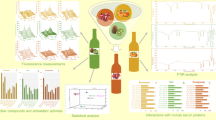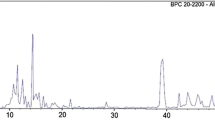Abstract
Antioxidant phytochemicals in fruits and vegetables of a vegetarian diet may account for the reduced risk of aging and stress oxidative associated diseases. In this study, a simple, rapid and accurate new bioassay for the determination of the antioxidant activity of purified or crude plant extracts and thier interactions is described, based on the fluorimetric determination of thiobarbituric acid reactive substances (TBARS) released by UV-B radiated red blood cell (RBC) ghosts. Pure resveratrol, white and red wine and pomegranate juice (PJ) were used as antioxidant source to test the biological method. TBARS production is a function of radiation time, the number of RBC ghosts in the radiated sample and the loaded antioxidant. The antioxidant activity of resveratrol was detected at a submicromolar concentration range [0.02 μg/mL–0.1 μmol/L]. The activity of red wine was almost 10 times higher than that of white wine, and PJ juice had the highest activity. Submaximal protective effects of PJ and red wine were additive.


Similar content being viewed by others
Abbreviations
- TBARS:
-
Thiobarbituric acid reactive substances
- MDA:
-
Malondialdehyde
- RBC:
-
Red blood cell
- PJ:
-
Pomegranate juice
- DPPH:
-
1,1-diphenil-2-picrylhydrazyl
- ABTS.+ :
-
2,2′-azinobis(3-ethyl-benzothiazoline-6-sulphonic acid) radical cation
- TEAC:
-
Trolox equivalent antioxidant capacity
- ORAC:
-
Oxygen radical absorption capacity
- PUFA:
-
Polyunsaturated fatty acids
- UV-B:
-
Ultraviolet-B
References
Willett WC (2002) Balancing life-style and genomics research for disease prevention. Science 296:695–698
Nabavi SM, Nabavi SF, Eslami S, Moghaddam AH (2012) In vivo protective effects of quercetin against sodium fluoride-induced oxidative stress in the hepatic tissue. Food Chem 132:931–935
Mikstacka R, Rimando AM, Ignatowicz E (2010) Antioxidant effect of trans-resveratrol, pterostilbene, quercetin and their combinations in human erythrocytes in vitro. Plant Foods Hum Nutr 65:57–63
Morton LW, Abu-Amsha Caccetta R, Puddey IB, Croft KD (2000) Chemistry and biological effects of dietary phenolic compounds: relevance to cardiovascular disease. Clin Exp Pharmacol Physiol 27:152–159
Elattar TM, Virji AS (1999) The effect of red wine and its components on growth and proliferation of human oral squamous carcinoma cells. Anticancer Res 19:5407–5414
Stagos D, Kazantzoglou G, Theofanidou D, Kakalopoulou G, Magiatis P, Mitaku S, Kouretas D (2006) Activity of grape extracts from Greek varieties of Vitis vinifera against mutagenicity induced by bleomycin and hydrogen peroxide in Salmonella typhimurium strain TA102. Mutat Res 609:165–175
Liu Y, He XQ, Huang X, Ding L, Xu L, Shen YT, Zhang F, Zhu MB, Xu BH, Qi ZQ, Wang HL (2013) Resveratrol protects mouse oocytes from methylglyoxal-induced oxidative damage. PLoS One 8:e77960
Mastrodi Salgado J, Baroni Ferreira TR, de Oliveira BF, Dos Santos Dias CT (2012) Increased antioxidant content in juice enriched with dried extract of pomegranate (Punica granatum) peel. Plant Foods Hum Nutr 67:39–43
Perez-Jiménez J, Arranz S, Tabernero M, Diaz-Rubio ME, Serrano J, Goñi I, Saura-Calixto F (2008) Updated methodology to determine antioxidant capacity in plant foods, oils and beverages extraction, measurement and expression of results. Food Res Int 41:274–285
Brand-Williams W, Cuvelier ME, Berset C (1995) Use of a free radical method to evaluate antioxidant activity. Lebenson Wiss Technol 28:25–30
Re R, Pellegrini N, Proteggente A, Pannala A, Yang M, Rice-Evans C (1999) Antioxidant activity applying an improved ABTS radical cation decolorization assay. Free Radic Biol Med 26:1231–1237
Prior RL, Hoand H, Gu LW, Wu XL, Bacchiocca M, Howard L, Hampsch-Woodill M, Huang DJ, Ou BX, Jacob R (2003) Assay for hydrophilic and lipophylic antioxidant capacity (oxygen radical absorption capacity (ORACFL) of plasma and other biological and food samples. J Agric Food Chem 51:3273–3279
Takebayashi J, Chen J, Tai A (2010) A method for evaluation of antioxidant activity based on inhibition of free radical-induced erythrocyte hemolysis. Methods Mol Biol 594:287–296
Rizvi SI, Jha R, Pandey KB (2010) Activation of erythrocyte plasma membrane redox system provides a useful method to evaluate antioxidant potential of plant polyphenols. Methods Mol Biol 594:341–348
Niki E, Komuro E, Takahashi M, Urano S, Ito E, Terao K (1988) Oxidative hemolysis of erythrocytes and its inhibition by free radical scavengers. J Biol Chem 263:19809–19814
Abella A, Messaoudi C, Laurent D, Marot D, Chalas J, Breux J, Claise C, Lindenbaum A (1996) A method for simultaneous determination of plasma and erythrocyte antioxidant status. Evaluation of the antioxidant activity of vitamin E in healthy volunteers. Br J Clin Pharmacol 42:737–741
Parentini I, Bergamini E, Cecchi L, Cavallini G, Donati A, Maccheroni M, Tamburini I, Gori Z (2003) The effect of carbon tetrachloride and ultraviolet radiation on dolichol levels in liver cells isolated from 3- and 24-month-old male Sprague–Dawley rats. Biogerontology 4:365–370
Guarini M, Stabile A, Cavallini G, Donati A, Bergamini E (2007) Effects of oxidative stress on the Dolichol content of isolated rat liver cells. Free Radic Res 41:1283–1288
Grotto D, Santa Maria LD, Boeira S, Valentini J, Charão MF, Moro AM, Nascimento PC, Pomblum VJ, Garcia SC (2007) Rapid quantification of malondialdehyde in plasma by high performance liquid chromatography-visible detection. J Pharm Biomed Anal 43:619–624
Alonso Barbolán AM, Zorro L, Guillen DA, Barroso CG (2003) Study of the polyphenol content of red and white grape varieties by liquid chromatography-mass spectrometry and its relationship to antioxidant power. J Chromatogr A 1012:31–38
Kim DO, Chun OK, Kim YJ, Moon HY, Lee CY (2003) Quantification of polyphenolics and their antioxidant capacity in fresh plums. J Agric Food Chem 51:6509–6515
Romani A, Mancini P, Tatti S, Vincieri FF (1996) Polyphenols and polysaccharides in Tuscan grapes and wines. Ital J Food Sci 1:13–24
Nigel CW, Glories Y (1991) Use of a modified dimethylaminocinnamaldehyde reagent for analysis of flavanols. Am J Enol Vitic 42:364–366
Waterman PG, Mole S (1994) Analysis of phenolic plant metabolites. In: Lawton JH, Likens GE (eds) Methods in ecology. Blackwell Scientific Publications, Oxford, pp 104–133
Kolouchová-Hanzlíková I, Melzoch K, Filip V, Šmidrkal J (2004) Rapid method for resveratrol determination by HPLC with electrochemical and UV detections in wines. Food Chem 87:151–158
Steck TL, Kant JA (1974) Preparation of impermeable ghosts and inside-out vesicles from human erythrocyte membranes. Methods Enzymol 3:172–180
Fernández-Pachón MS, Villaño D, Garcia-Parrilla MC, Troncoso AM (2004) Antioxidant activity of wines and relation with their polyphenolic composition. Anal Chim Acta 513:113–118
Seeram NP, Aviram M, Zhang Y, Henning SM, Feng L, Dreher M, Heber D (2008) Comparison of antioxidant potency of commonly consumed polyphenol-rich beverages in the United States. J Agric Food Chem 56:1415–1422
Gil MI, Tomás-Barberán FA, Hess-Pierce B, Holcroft DM, Kader AA (2000) Antioxidant activity of pomegranate juice and its relationship with phenolic composition and processing. J Agric Food Chem 48:4581–4589
Acknowledgments
The present research was supported by funds of the University of Pisa. The authors declare no conflict of interest. The authors thank Gian Pietro Molinari and Luigi Lucini (Istituto di Chimica Agraria e Ambientale, Università Cattolica del Sacro Cuore di Piacenza, Italy) for critical reading of the manuscript and their helpful contribution for HPLC analysis.
Conflict of interest
Each author declare that they have not a Conflict of Interest. This article does not contain any studies with human subjects.
Author information
Authors and Affiliations
Corresponding author
Rights and permissions
About this article
Cite this article
Cavallini, G., Dachà, M., Potenza, L. et al. Use of Red Blood Cell Membranes to Evaluate the Antioxidant Potential of Plant Extracts. Plant Foods Hum Nutr 69, 108–114 (2014). https://doi.org/10.1007/s11130-014-0414-0
Published:
Issue Date:
DOI: https://doi.org/10.1007/s11130-014-0414-0




